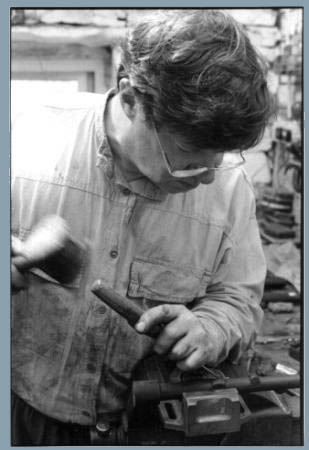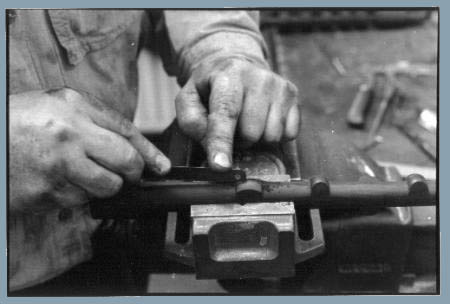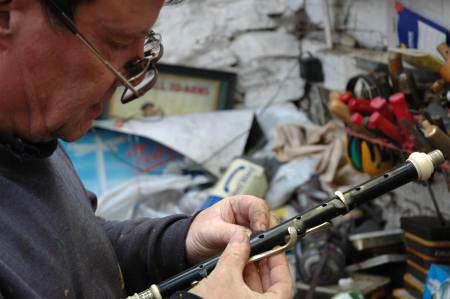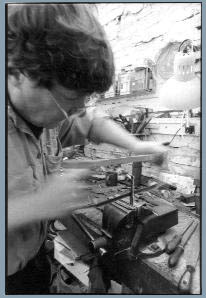|

| playing the piper |
Demand exceeds supply for Clare artisan's
handmade uilleann pipes
By Pól Ó Conghaile
Photos by Peter Laban
Photo © Peter Laban  Geoff Wooff was stuck. On the phone from Milltown Malbay, Co. Clare, the legendary uilleann pipemaker sounded busy, frustrated. Maybe we could visit, maybe not.
Geoff Wooff was stuck. On the phone from Milltown Malbay, Co. Clare, the legendary uilleann pipemaker sounded busy, frustrated. Maybe we could visit, maybe not.
It was just that interviews took time, and time was scarce -- he'd recently spent 18 hours tuning a troublesome instrument. Best leave it for the weekend, see if he could turn the corner.
By the time we got to County Clare, everything made sense. A sullen octopus of leather, ebony, boxwood and metal lay on Wooff's knee. Strapping himself in, the bag wheezed and groaned, bloating uncomfortably. Its birth had been awkward, raucous even, but at least it now sounded like music. "One could look at it and say, 'What takes such a long time?' " he said. "But it just does."
Hailing from Lewisham in South London, making pipes for a quarter of a century, this is a man at the peak of his profession. Handmade to the last, devilish detail, his product is world renowned, his waiting list extends into retirement.
It's not hard to see why. Ordered in 1997, the set on his knee was bound for San Francisco.
"The climate there is different, damper than Southern California," Wooff said. "Reeds can open or tighten depending on the humidity, you see. He's certainly been waiting a long time. Now I've got to get it to work."
Brian McNamara, a celebrated South Leitrim piper, sketches the magic. "Imagine a block of wood and a sheet of metal and then look at the finished instrument," he said. "A lot of pipers aspire to owning a golden set from the 1800s. Geoff isn't just replicating those; he's adding finesse and an incredible attention to detail. I wouldn't want any other set in the world."
Wooff is a Huguenot name, traceable to Flemish weavers who journeyed to Britain in the 1700s, but his mother's people were Irish. It shows. Wooff's first instrument was a recorder, at age 6. Planxty and the Bothy Band formed a childhood soundtrack. At 16, he began a formal engineering apprenticeship. By his mid-20s, he had worked as a machinist and draftsman, adding concertina and tin whistle to his repertoire on the London folk club scene in the 1970s.
One couldn't script a better preamble. "The uilleann pipemaker is making one thing out of a lot of different materials, as opposed to a tailor or a potter, who is making lots of things out of one material," he said. "For me, it perfectly mixes the skills that I learned as a child. The only difficulty was getting an instrument."
His problem was a familiar one. At the time, despite an illustrious history, the uilleann pipes were fast becoming victims of their own complexity. The Taylor brothers made efforts in American auditoriums in the early 20th century; Séamus Ennis, Johnny Doran and Willie Clancy did the same later in Ireland, but their efforts couldn't stop the decline. By the 1960s, few musicians were playing the pipes, fewer still making them.
"There was a great maker up in Dublin, Leo Rowsome, who died in the 1970s," Wooff recalled. "Matt Kiernan and Dan O'Dowd were in their early 80s then, and you practically had to know them personally to get an instrument. There was virtually nobody making them."
By the time Wooff's own career took off, after moving to Australia in 1976, the craft was all but dying.
"I had wanted a set of pipes for several years and my then wife, Joan, being a very typical Australian, said, 'You're supposed to be an engineer, why don't you make your own?' " Wooff said. "But you can't start from scratch. You need something to model your work on. It's a very tricky piece of equipment."
Fate was on his side. Just as he bought a lathe and a supply of wood, a second-hand dealer turned up in Perth with a box of uilleann pipe bits. It looked like a mess, but piecing them together, Wooff found himself assembling a flat set made by Harrington of Cork in 1852.
"He said, 'I know you're interested in these things, so what will you give me for them?' " Wooff said. "At the time, we had a baby on the way and it was more than all the money I had. But it had to be done."
Hearing him play convinces you of that. Sitting on a grassy verge in Cloghanmore, bellows to elbow and leather upon lap, the pitch is a plaintive C and surprisingly quiet. When he embarks on a tune, a turtleshell cat stirs by the stove. It is soft, sad and strong, all at once.
19th century heyday
Native to Ireland for 300 years, the uilleann pipes reached their heyday in the early 19th century, when names like Egan, Coyne and Harrington were synonymous with the craft. By 1852, this set would have cost £50 -- "a year's pay for someone in a very good job." It's a beautiful piece of work, with no more than the leather and a couple of reeds replaced.
The maker had found his model. "I went down to the boat club and played the old pipes and someone came running out saying, 'Where did you get that? I want one of those.' It went from there," Wooff said.
Photo © Peter Laban  By 1989, inevitably perhaps, he was bound for Clare. "It wasn't just for business reasons; what attracted me here was the music, and having visited during Willie Clancy Week, I knew it would be a good place to move to," Wooff said. "There was romance as well. I'd visited six or seven times and it was here that I met my current wife [Gabi, also an enthusiastic musician]. She's from Germany so we decided that we should both move to Ireland.
By 1989, inevitably perhaps, he was bound for Clare. "It wasn't just for business reasons; what attracted me here was the music, and having visited during Willie Clancy Week, I knew it would be a good place to move to," Wooff said. "There was romance as well. I'd visited six or seven times and it was here that I met my current wife [Gabi, also an enthusiastic musician]. She's from Germany so we decided that we should both move to Ireland.
"There were some lean years initially. You could come into a shop here, throw all the money in your pockets onto the counter and say, 'Take the lot.' Even just to buy a few basics. But things picked up. It could be 'Riverdance,' 'Titanic' or 'Braveheart,' but people began hearing the pipes in a mass situation. The Internet has had an impact as well -- information is getting around far more quickly. By 1995-96 pipes were being ordered three or four times faster than I could make them."
It is certainly true that uilleann pipes are enjoying a revival. Since the late 1960s the national pipers' society, Na Piobairi Uilleann, has perpetuated the playing and maintenance of the instrument; interest in traditional music in general has flowered and innovative players like Liam O?Flynn, Paddy Moloney and Paddy Keenan have driven the pipes onto the contemporary stage.
"There are far more sets around, but there are far more people looking to play those sets," said Terry Moylan, archivist with Na Piobairi Uilleann. "What that means is that, although the relationship of supply and demand remains the same, the culture is doing extremely well. There are probably more people playing now than at any time since the Famine."
Idiosyncratic instrument
Complexity remains of the essence. Of more than 200 types of bagpipes, uilleann pipes are the most idiosyncratic and evolved. Wood, metal and cane combine to blow at least two octaves and the half-steps between; dry reeds and an elbow-inflated bag facilitate the signature sweetness of tone. They may be daunting to master, but freed from the strictures governing highland bagpipes, uilleann pipers are rewarded with an orchestral gem, capable of a wide variety of highly individualistic styles.
"We were lucky to have moved here at a time when there were still some of the old musicians out playing," Wooff said, "people like Junior Creahan, Michael Russell and Michalin Conlon. Of course, it's impossible to copy somebody else's music. You can see that with Johnny Doran, who died in the late 1940s. There are a few recordings of him and some of the younger people have taken on his style. But they're each different, and none of them, to my ears, sounds like Johnny Doran. The ideas are there, but the individual's personality still comes through."
Wooff can still be heard playing the odd session in Milltown Malbay, although the late nights are dwindling now. "We were doing three or four a week at one stage because we had access to such a wealth of musicians," he said. "But that doesn't fit in too well with the working lifestyle, if you know what I mean. I'm glad we did it while we had the chance. Just to see what they were doing and learn how they did it -- that was a very important resource."
The point recalled one made earlier in a discussion of the Harrington set. To build a good set of uilleann pipes, he said, "you need a good working instrument that you've learned to play. It's sort of like the source -- like being with an old musician who has been playing so long you can ask them how they're doing something, but they'll simply put their hand on the neck of the fiddle and say this tune starts here."
Clearly, Wooff is sensitive to the interrelationship of music, musician and maker. "Geoff is a good technician, a very good piper and he has made it his business to understand the work of the men who made this instrument in the golden age," Terry Moylan said. "But most of all he is making and selling into the tradition, and that's something I admire him for."
Photo © Peter Laban  Manufacturing magic
Manufacturing magic
The manufacturing happens behind the Wooffs' colorful cottage, in a tiny workshop in the shadow of Mount Callan. Chisels hang every which way; there is a hulking lathe, a pouch of tobacco, clucking hens all about. Producing just three or four instruments a year, all of the metal pieces, cut from a sheet and fashioned into tubes of four or five different depths, are hewn by hand. But there is much more.
There is Madagascar ebony, left to season for 5 years. ("You can see that if there were a fault two-thirds of the way down that tapered bore in the charters, it would affect the way the pipes were played," Wooff said.)
There is boxwood from the Pyrenees, mammoth tusk from Siberia. ("There's elephant ivory on the Harrington, but that's no longer PC," Wooff said. "This is supposed to be fossilized but was actually frozen for about 10,000 years.")
The depth and detail of knowledge is intoxicating, but then it has to be. As one of fewer than 50 pipemakers on the planet, Wooff makes every piece of every set himself. Each instrument takes over 300 hours to build.
"Geoff's instruments have a very distinctive sound," said Máire Ní Ghráda, a distinguished Limerick-based piper. "There's a sense of the old in them and the tone is extremely rich. When the drones, regulators and chanter come together, they really sing; there's a wonderful resonance. An early tutor describes the uilleann pipes as a little band in themselves, and I think Geoff's are a perfect illustration of that. There's a beautiful balance to his sets."
"It's in the tonal quality, the balance and the playability," said Brian McNamara. "My piping life has taken off since receipt of the set; it's been an absolute renaissance. I've traveled the world and they've never let me down."
Said Wooff: "Basically, what I'm trying to do is create an instrument that's as good as the old one. OK, we have electricity these days and so on, but the blueprint is the same. The difficulty is not with playing the pipes -- I honestly don't believe that's too hard, it's getting them to work in a way that they can be played. It really is very tricky."
Inevitably perhaps, given the intensity of the craft and the prices his reputation now command, orders have become more selective.
Photo © Peter Laban  "Time does a lot of things as you get older," Wooff said. "It makes you tired, it makes you fussier. At one stage I couldn't afford the luxury of being fussy, both financially and because, while I might have known something wasn't as good as I wanted it to be, I didn't know why. Now I do. That has taken 25 years and a hell of a lot of work."
"Time does a lot of things as you get older," Wooff said. "It makes you tired, it makes you fussier. At one stage I couldn't afford the luxury of being fussy, both financially and because, while I might have known something wasn't as good as I wanted it to be, I didn't know why. Now I do. That has taken 25 years and a hell of a lot of work."
It also means that if you place an order with Geoff Wooff this afternoon, your uilleann pipes won't arrive until 2018. That's a 14-year waiting list, and a satisfied shrug of the shoulders. His arm might be twisted, though -- if you can play like those who instilled in him a love for this awkward and beautiful instrument in the 1970s.
"Yes, I might make an exception then," Wooff said. "Seeing a set of your pipes used by a good player is the ultimate kick. You're facilitating the production of that music and that's what it's all about -- when you're sitting listening to someone on stage, and it dawns on you, 'I made all of that.' "
He looks back at the newest set, almost ready for export. Its complexity seems almost good-humored now, and he smiles. "Then you go, 'Oh, God, what's going to go wrong?' "
|
|
 |
